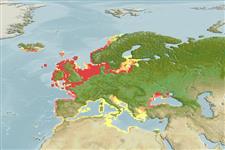Common names from other countries
Environment: milieu / climate zone / depth range / distribution range
Ecología
marino; salobre demersal; oceanodromo (Ref. 51243); rango de profundidad 20 - 70 m (Ref. 6302). Temperate; 70°N - 30°N, 25°W - 42°E
Northeast Atlantic: throughout the Mediterranean and along the European coasts to Arctic Circle; also found in most of the Baltic Sea. Subspecies Psetta maxima maeotica in the Black Sea.
Length at first maturity / Tamaño / Peso / Age
Maturity: Lm 40.8, range 41 - 54 cm
Max length : 100.0 cm SL macho / no sexado; (Ref. 4703); common length : 50.0 cm TL macho / no sexado; (Ref. 35388); common length :70 cm TL (female); peso máximo publicado: 25.0 kg (Ref. 9988); edad máxima reportada: 25 años (Ref. 32766)
Body almost circular. Eye side without scales but with large bony tubercles (Ref. 35388).
Adults live on sandy, rocky or mixed bottoms; rather common in brackish waters. Feed mainly on other bottom-living fishes (sand-eels, gobies, etc.), and also, to a lesser extent, on larger crustaceans and bivalves. Batch spawner (Ref. 51846). Spawning season is between April and August; pelagic eggs. May reach 25 kg (Ref. 9988). Highly esteemed food fish. Utilized fresh or frozen; eaten steamed, pan-fried, broiled, boiled, microwaved and baked (Ref. 9988).
Spawning usually happens between the months of February and April in the Mediterranean and from May to July in the Atlantic. Sequenced spawning every 2-4 days. Eggs have a single fat drop. Larvae are initially symmetric but, at the end of the metamorphosis (day 40-50, 25 mm), the right eye moves to the left side, losing its initial bilateral symmetry. Egg size 0.9 - 1.2 mm, larval length at hatching 2.7-3.1 mm.
Bauchot, M.-L., 1987. Poissons osseux. p. 891-1421. In W. Fischer, M.L. Bauchot and M. Schneider (eds.) Fiches FAO d'identification pour les besoins de la pêche. (rev. 1). Méditerranée et mer Noire. Zone de pêche 37. Vol. II. Commission des Communautés Européennes and FAO, Rome. (Ref. 3397)
IUCN Red List Status (Ref. 130435)
CITES (Ref. 128078)
Not Evaluated
Threat to humans
Harmless
Human uses
Warning: mysqli::__construct(): (HY000/1040): Too many connections in /var/www/html/includes/func_getlabel.php on line 46
Can't connect to MySQL database (fbapp). Errorcode: Too many connections
